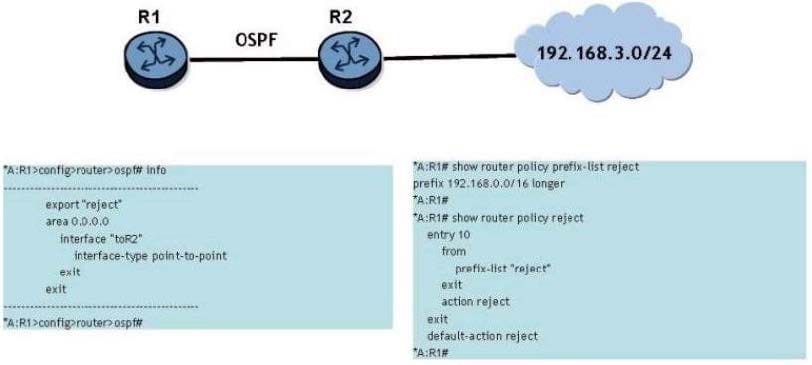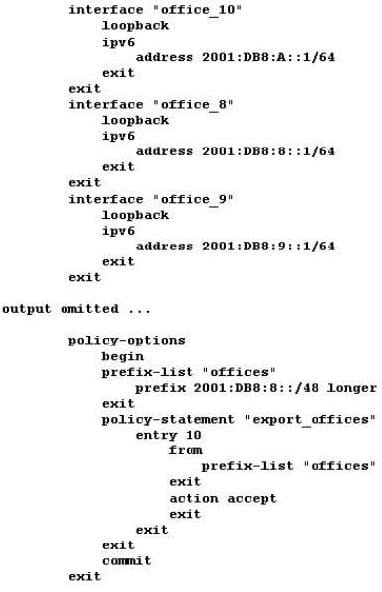Exam Details
Exam Code
:4A0-101Exam Name
:Nokia Interior Routing ProtocolsCertification
:Nokia CertificationsVendor
:NokiaTotal Questions
:315 Q&AsLast Updated
:Aug 14, 2025
Nokia Nokia Certifications 4A0-101 Questions & Answers
-
Question 21:
In OSPFv3, which of the following LSA types carries prefixes and is only flooded in the area where it is generated?
A. Link
B. AS External
C. Router
D. Intra-Area Prefix
-
Question 22:
Click on the exhibit.

192.168.3.1 is a loopback interface on router R2 and is distributed to OSPF area 0, but the ping fails from router R3. Which of the following is a possible solution to the problem?
A. Add "stub no summaries" to the area 1 configuration on router R1.
B. Add the "originate-default-route" option in the area 1 configuration on router R1.
C. Add a default static route on router R3.
D. Include the system interface in the area 1 configuration on router R3.
E. Add a static route on router R3 to 192.168.3.1.
-
Question 23:
Which of the following describes the purpose of 6over4 tunneling?
A. To give IPv6 traffic preferential routing over IPv4 routes.
B. To allow core routers running only IPv6 protocols to carry IPv4 traffic.
C. To give IPv4 only routers the ability to route based on IPv6 addresses.
D. To allow IPv6 traffic to pass through an IPv4 network.
-
Question 24:
Click on the exhibit.

Router R2 has a directly connected interface to network 192.168.3.0/24 that is included in IS-IS.
If router R4 redistributes the IS-IS route to 192.168.3.0/24 into OSPF, router R3 will receive two routes to
192.168.3.0/24. Assume that all IS-IS routers are L1/L2 capable and are in the same area.
Which of the following is TRUE?
A. Router R3 will install the IS-IS route in it's routing table.
B. Router R3 will install the OSPF route in it's routing table.
C. Router R3 will install an OSPF route and an IS-IS route in it's route table.
D. There is not enough information to answer the question.
-
Question 25:
Click on the exhibit.

Router R2 uses OSPF to advertise the network 192.168.3.0/24 to router R1. A route policy has been configured to reject the route on router R1.
Why doesn't the route policy work?
A. The prefix list "reject" should be "192.168.3.0/16 exact".
B. Router R1 should be configured as an OSPF "asbr".
C. The policy was not "committed" after creation.
D. Router R1 cannot reject the route because OSPF does not support import policies
-
Question 26:
Why does IPv6 not use ARP?
A. The ARP functionality has been replaced by the Neighbor Discovery protocol.
B. The ARP functionality is not needed due to the increased IPv6 address space.
C. ICMPv6 reduced its role to connectivity checking and auto-configuration only.
D. ICMFV6 replaced the ARP functionality with Multicast Listener Discovery (MLD).
-
Question 27:
Two IS-IS routers are exchanging Hello packets with different authentication types. Which of the following is TRUE?
A. Different authentication types are not possible because IS-IS only supports password authentication.
B. An adjacency will not be formed.
C. The two routers negotiate the authentication type and then reach the up state.
D. Only an L2 adjacency will form, as long as both routers are L2 capable.
-
Question 28:
Which of the following route types must be manually configured and will not re-route traffic when a link failure occurs in its path?
A. A route from IS-IS.
B. A route from OSPF.
C. A floating static route.
D. A static route.
-
Question 29:
An IS-IS router receives a CSNP that references an older LSP than the one in its database. What action is taken?
A. The router sends a copy of the LSP from its database to its neighbor.
B. The router sends a PSNP to its neighbor describing the LSP in its database.
C. The router updates its database with the LSP and floods a copy to its other neighbors.
D. The router sends a PSNP to its neighbor to request the LSP.
-
Question 30:
Click on the exhibit.

An OSPFv3 router is attached to a non-OSPF domain that includes networks 2001:DB8:8::/64.2001 .DB8:9::/64 and 2001 :DB8:A::/64. Other routers in the OSPF domain see the prefix 2001, DB8:8::/64, but not the other two prefixes.
What could cause this?
A. The router is not configured as an asbr.
B. The router is not configured as an NSSA.
C. The export policy is not applied to OSPFv3.
D. The prefix list should be 2001:DB8:8::/46
Related Exams:
4A0-100
Nokia IP Networks and Services Fundamentals4A0-101
Nokia Interior Routing Protocols4A0-102
Nokia Border Gateway Protocol for Internet Routing4A0-103
Nokia Multiprotocol Label Switching4A0-104
Nokia Services Architecture4A0-105
Nokia Virtual Private LAN Services4A0-106
Nokia Virtual Private Routed Networks4A0-107
Nokia Quality of Service4A0-108
Nokia Multicast Protocols4A0-109
Alcatel-Lucent Triple Play Services
Tips on How to Prepare for the Exams
Nowadays, the certification exams become more and more important and required by more and more enterprises when applying for a job. But how to prepare for the exam effectively? How to prepare for the exam in a short time with less efforts? How to get a ideal result and how to find the most reliable resources? Here on Vcedump.com, you will find all the answers. Vcedump.com provide not only Nokia exam questions, answers and explanations but also complete assistance on your exam preparation and certification application. If you are confused on your 4A0-101 exam preparations and Nokia certification application, do not hesitate to visit our Vcedump.com to find your solutions here.